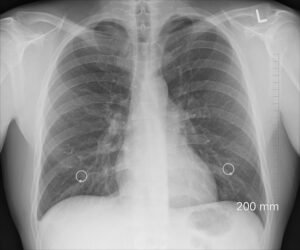Sarcoid and ANCA vasculitis lung introduction
In this article, we will talk about granuloma. In contrast to last article where we talked about lung disease with issues at the base of the lung. Now we talk about ball like lesions called granuloma. Keep in mind that a large number of ball-like lesions on the lung are found by mistake and do NOT indicate anything serious and just needs pictures repeat in 3 to 12 months. Obviously, if patient is a smoker or was exposed to chemical fumes consistently, we think of cancer “work up” -such as biopsy or special scans called PET scan. Here though I will focus on why do lung docs (pulmonologist) send patients to Rheumatologist.
What lung lesions could be?
Keep in mind if cancer risk is low and your lung doctor is concerned, they need to rule out infection first and foremost. Infection could be fast (bacteria) or slow (fungus/parasite). The way is typically doing a bronchoscopy with samples. Bronchoscopy is a tube that goes through the mouth into the lung tubes to take samples for cultures and possibly biopsies (small piece of the lung). Let us say the lung doctor is sure this is NOT infection and not cancer and the lesions are getting bigger. Then the lung doctor might send you to a Rheumatologist. I will mention two diseases and describe them, then go from there:
Sarcoidosis
The first is Sarcoidosis. Sarcoidosis is called a granuloma disease. Which is a specific organization of white blood cells in the lung. It is a type of autoimmune disease that typically only affects the lungs. Not commonly can affect other organs but usually not. Therefore, most sarcoidosis patients only see pulmonologist.
These patients might present as asthma (such as cough and reduced FEV1/FVC). It would be generally managed as asthma. Occasionally, despite lung doctors amazing expertise, the disease is not responding to asthma medications. A lung doctor would refer to Rheumatologist specifically to start disease modifying agents such as methotrexate or biologics such as Remicade. At times Rheumatologist based on history might send you to other types of doctors/specialists or do other tests to see if Sarcoid is affecting other organs.
ANCA vasculitis granuloma
The second disease is ANCA associated vasculitis granuloma. Brief on the blood test ANCA, it a worse test than ANA. This test can be positive in chronic infections, illicit drug uses (cocaine), inflammatory bowel disease, and even normal people. So does this test matter. The ANCA test was designed to be sent in people who have something called pulmonary-renal syndrome. These patients who get relatively quick worsening of kidney function (with protein and blood in urine that does not have clear explanation) and shortness of breath. Occasionally these patients will cough up blood. Classically this disease is seen in middle age Caucasian population.
This ANCA vasculitis can also show up as granulomas on the lung that grow in size if not treated. I have seen ANCA vasculitis granuloma only on inpatient service in the hospital. I never seen it come from clinic, unless was already diagnosed at a hospital. The reason likely that these cases progress quickly and patient does not even have time to see their primary provider followed by lung doctor. Therefore, generally when I get a granuloma and ANCA testing positive, I almost always ask for lung biopsy to rule out cancer and infections as they are more likely when presenting that slow to a clinic.
Summary
In summary, if someone has a ball on the CT of the lung, it is mostly not autoimmune. Generally, biopsy is needed to rule out infections (slow and fast) and cancers (slow and fast ones too). Usually if there is no shortness of breath and PFT is normal, the ball is less likely to autoimmune and quite possibly just a benign (meaning does not shorten life span or cause medical issue) lesions.

Park HJ, Jung JI, Chung MH, Song SW, Kim HL, Baik JH, Han DH, Kim KJ, Lee KY -Korean journal of radiology(2009 Nov-Dec) https://creativecommons.org/licenses/by-nc/3.0/



